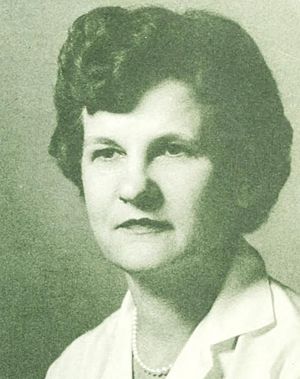Ruth R. Benerito facts for kids
Quick facts for kids
Ruth Mary Rogan Benerito
|
|
|---|---|
 |
|
| Born |
Ruth Mary Rogan
January 12, 1916 New Orleans, Louisiana, U.S.
|
| Died | October 5, 2013 (aged 97) Metairie, Louisiana, U.S.
|
| Nationality | American |
| Alma mater | Sophie Newcomb College, Tulane University |
| Known for | Wrinkle-free fiber |
| Spouse(s) | Frank Benerito |
| Awards | Garvan Medal, Lemelson-MIT Prize, National Inventors Hall of Fame |
| Scientific career | |
| Fields | Physical chemistry of surfaces and colloids |
| Institutions | University of Chicago, USDA Southern Regional Research Center, Tulane University, University of New Orleans. |
| Doctoral advisor | Thomas F. Young |
Ruth Mary Rogan Benerito (born January 12, 1916 – died October 5, 2013) was an American chemist and inventor. She is famous for her work with the textile industry. She helped create wash-and-wear cotton fabrics. These fabrics are much easier to care for. She held 55 patents for her inventions.
Contents
About Ruth Benerito's Early Life
Ruth Mary Rogan Benerito was born in New Orleans in 1916. Her father, John Edward Rogan, was a civil engineer. He worked for railroads. Ruth described him as a supporter of women's rights.
Her mother, Bernadette Elizardi Rogan, was an artist. Ruth saw her mother as a "truly liberated woman." Both parents went to college. They taught Ruth the importance of education and women's rights.
Ruth Benerito grew up during the Great Depression. This was a time when many Americans could not find jobs. When she earned her first degree in Chemistry, many people were unemployed. Ruth was first interested in math. But she did not want to be an actuary. Actuaries estimate risks for insurance companies. So, she decided to study chemistry instead.
Later in her life, Ruth thought about her many achievements. She showed her true character by saying: "I believe that whatever success that I have attained is the result of many efforts of many people. My very personal success was built from the help and sacrifices of members of my family, and professional accomplishments resulted from the efforts of early teachers and the cooperativeness of colleagues too many to enumerate." She believed her success came from many people helping her.
Ruth Benerito's Education Journey
When Ruth was young, it was not common for girls to go to college. But her father made sure his daughters got the same education as boys. Ruth finished high school at age 14. She then started college at 15.
She attended Sophie Newcomb College, which was the women's college at Tulane University. There, she earned a degree in chemistry. She also studied physics and math. She graduated in 1935. Then, she spent a year doing graduate studies at Bryn Mawr College.
After that, she returned to Newcomb College. She taught chemistry there. She also did research in many areas of chemistry. While teaching, Ruth took night classes. She earned her master's degree from Tulane University.
In 1948, she earned her doctorate degree (PhD) from the University of Chicago. Her research focused on physical chemistry. Her PhD paper was about how certain chemicals behave in water. In 1953, she left her teaching job at Newcomb College. She began working at the USDA Southern Regional Research Center in New Orleans. This is where she spent most of her career.
At the USDA, she worked on a program about fats. In 1955, she became a project leader. She was promoted again in 1958. She became the acting head of a lab that studied cotton chemicals. In 1959, she led the Physical Chemistry Research Group. In 1972, she completed more advanced studies in biophysics at Tulane University. She also taught part-time at Tulane University and the University of New Orleans for many years.
She retired from the USDA in 1986. But she kept teaching part-time at Tulane and the University of New Orleans.
Ruth Benerito's Key Contributions
Developing Wrinkle-Free Cotton
Ruth Benerito is most famous for her work with cotton. She found a way to use certain chemicals to make cotton better. She held 55 patents for her inventions. While working at the U.S. Department of Agriculture (USDA) in the 1950s, she invented wash-and-wear cotton fabrics. These fabrics are more wrinkle-free and last longer.
Before her invention, families spent a lot of time ironing clothes. Benerito found a chemical treatment for cotton. This made the fabric not only wrinkle-resistant but also stain-resistant and flame-resistant. People said her invention "saved the cotton industry."
Even though she is known for inventing wrinkle-free fabric, she did not think she did it alone. In a 2004 interview, she said: "I don't like it to be said that I invented wash-wear because there were any number of people worked on it and the various processes by which you give cotton those properties. No one person discovered it or is responsible for it, but I contributed to a new process of doing it." She believed many people helped develop it.
The secret to her invention is a process called crosslinking. Cotton is made of a natural material called cellulose. Cellulose is a polymer, like nylon and polyesters. Polymers have molecules shaped like long chains. These long chains make cellulose a good fiber.
Benerito found a way to treat cotton fibers. This treatment chemically joined the cellulose molecules together. This process, crosslinking, makes cotton resistant to wrinkling. Her big discovery was finding an additive. This additive chemically attached to the cellulose chains. It made the surface of the fabric smoother.
At first, scientists thought crosslinking made cotton stronger. But the amount of crosslinking Benerito used was small. It did not add much strength. So, she developed a new idea about how crosslinking works. Cellulose molecules can stick to each other using weak hydrogen bonds. She suggested that her crosslinking process made these hydrogen bonds stronger. This made the material resistant to wrinkling.
Creating Laboratory Equipment
Ruth Benerito's research also led to new types of glassy fibers. These fibers were useful for making laboratory equipment.
Helping Wounded Soldiers
During the Korean War, Ruth Benerito made another important contribution. She developed a way to give fat to patients through an IV. This helped feed seriously wounded soldiers who could not eat normally.
Awards and Honors
- 1964 USDA Distinguished Service Award
- 1968 Federal Woman Award
- 1968 Southern Chemist Award
- 1970 Garvan Medal
- 1971 Southwest Regional Award of American Chemical Society
- 1981 Honorary degree, Tulane University
- 1984 Woman of Achievement at World's Fair
- 2002 Lemelson-MIT Lifetime Achievement Award
- 2008 National Inventors Hall of Fame induction
See also
 In Spanish: Ruth R. Benerito para niños
In Spanish: Ruth R. Benerito para niños


